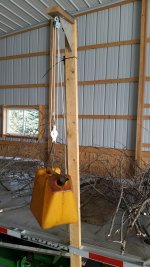Industrial Toys
Super Star Member
- Joined
- Feb 25, 2008
- Messages
- 16,742
- Location
- Ontario Canada
- Tractor
- Kubota R510 Wheel Loader + Cab and backhoe, JD 6200 Open Station, Cushman 6150, 4x4, ten foot 56 hp Kubota diesel hydraulic wing mower, Steiner 430 Diesel Max, Kawasaki Diesel Mule, JD 4x2 Electric Gator
Just a question that I can't get my head around.
For argument, let's say you are lifting a load. You have a block and tackle (hook) attached to the load.
One end of the line goes to your winch or vehicle frame.
The Other goes to your winch drum.
So in theory you have multiplied the pulling force of the winch many times.
But really you have the weight of the load divided by two on your frame and the other half on the drum.
So, how can it be easier to pull, when the Static weight is still there?
Clearly, I must be missing something.
For argument, let's say you are lifting a load. You have a block and tackle (hook) attached to the load.
One end of the line goes to your winch or vehicle frame.
The Other goes to your winch drum.
So in theory you have multiplied the pulling force of the winch many times.
But really you have the weight of the load divided by two on your frame and the other half on the drum.
So, how can it be easier to pull, when the Static weight is still there?
Clearly, I must be missing something.


